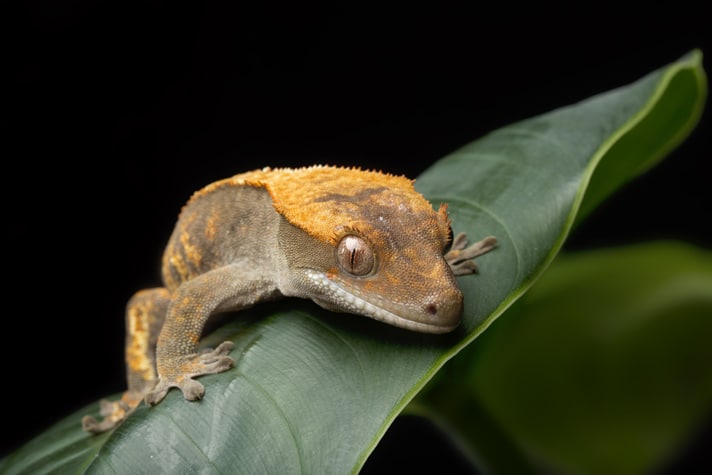A more natural approach to keeping America’s favorite pet gecko.
It’s not often that something comes along that turns an industry on its head. Paper towels and newspaper have long been staple substrates for keepers of many different species for years, but the times are changing. Along with a push to provide our beloved herps with a more natural, aesthetically pleasing habitat, the bioactive movement promises a better standard of care with a fraction of the time required to keep our critters clean.
With great power comes great responsibility, and while the potential benefits of bioactive keeping are certainly powerful, there is an added responsibility to first do no harm. Setting up a bioactive enclosure is not as straightforward as your more typical habitat. Additional research and planning is required to ensure success. As the primary care giver, you’ll also need to keep a close eye on the conditions in the habitat, ensuring the bioactive system is functioning as expected. If not done properly, bioactive enclosures can and will harm your pet. If done correctly, they’ll provide a rich, appealing environment you and yours will enjoy for years to come.
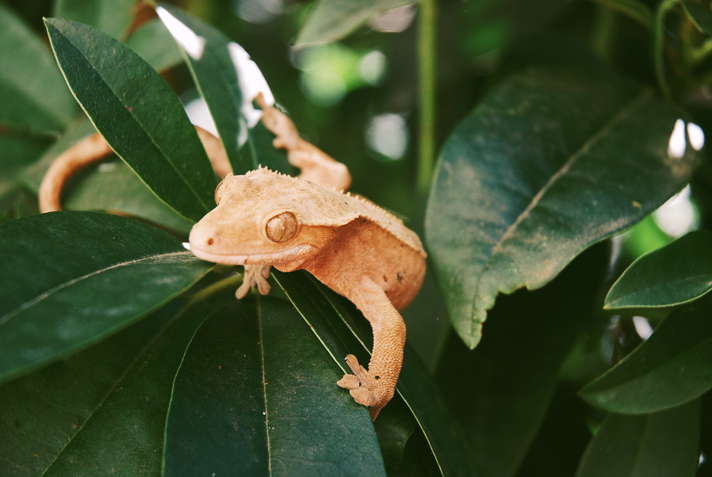
Catherina Reynolds/Shutterstock
A more naturalistic crested gecko enclosure is also more pleasing on the eyes.
What is a Bioactive Enclosure?
Bioactive is simply the latest trendy term for setting up an enclosure in a way that resembles the native habitat of its inhabitants and relies on live plants, invertebrates and fungi to help control waste. In the past, this approach to husbandry has also been referred to as keeping a naturalistic terrarium or vivarium. Fortunately for you and your pets, there has been a recent surge in interest in constructing a bioactive enclosure, and more information is available than ever before. Once viewed as an odd (and sometimes dangerous!) approach to animal keeping, this trend is slowly becoming mainstream, with many of the larger online pet supply stores offering lines of basic bioactive supplies.
The Benefits of Bioactive
Besides constructing a small slice of nature indoors which is yours to enjoy year round, bioactive enclosures have many additional benefits, including but not limited to:
- Aesthetically pleasing
- Low-maintenance
- Promote natural behaviors
- Reduce/eliminate habitat for pests and parasites to take hold
- Provide many different micro-climes
Why Crested Geckos?
Almost any species can be kept in a bioactive enclosure. In the past year, I’ve been asked to help design bioactive terraria for a wide variety of species—from ball pythons to monitors; chameleons to leopard geckos; the possibilities are endless. The most ambitious build involved a small greenhouse and a green iguana! With all these options, why would I choose to write an article on one of America’s favorite pet geckos? I do so because this species, which makes such a great “gateway reptile” for new keepers, also makes a great first introduction to the next big thing in herp keeping.
Zach Brinks
Cleaning is minimal in a crested gecko bioactive habitat and primarily involves cleaning poop off glass.
As hobbyists master the care (and possibly reproduction) of their first species of reptile or amphibian, they look to the next challenge. Traditionally, this means hunting down more obscure or difficult species, or distantly related species that offer something that their first pet didn’t. By keeping crested geckos in a bioactive enclosure, the hobbyist is actively improving the well-being and care of the animal they already have. It is my sincere hope that future reptile and amphibian keepers will go this route, instead of the route of an advanced hobbyist or serious breeder with a room filled with small tanks, with basic setups to facilitate easy cleaning. I hope to see more keepers with fewer, larger enclosures, set up in a bioactive fashion, with more animals displaying naturalistic behaviors and living a healthy, extended lifespan. Bioactive enclosures enable us, as dedicated keepers, to do more with the animals we have.
Two Basic Approaches to Bioactive Herp Enclosures
There are two different schools of thought when it comes to designing and constructing a bioactive enclosure—the Naturalists and the Engineers. The Naturalists tend to use “wild-caught” supplies in their construction and do little, if any, sterilization. The Engineers utilize carefully crafted substrates and seek to find a balance between sterilizing supplies (to prevent the introduction of unwanted pests and parasites) and keeping the enclosure functioning as a miniature naturalistic ecosystem.
Bioactive keeping au naturel has many benefits. A big one is cost—it doesn’t get much cheaper wandering into the local woods and digging up some dirt and leaves and fishing a few pieces of driftwood from a nearby creek. This also makes it pretty easy to replicate a natural environment by simply collecting pieces of it and sticking them in a glass box! Items are not sterilized; at best, they may be rinsed. Many different varieties of fungi and invertebrates are thus introduced into the bioactive enclosure. The hope is that they will reach some sort of equilibrium where beneficial fungi and inverts will outnumber and eventually eliminate the bad ones. There is a risk of unintentionally introducing harmful organisms into your bioactive enclosure. Once introduced, the only sure way to purge your habitat of pests is a full tear down and rebuild with new materials.
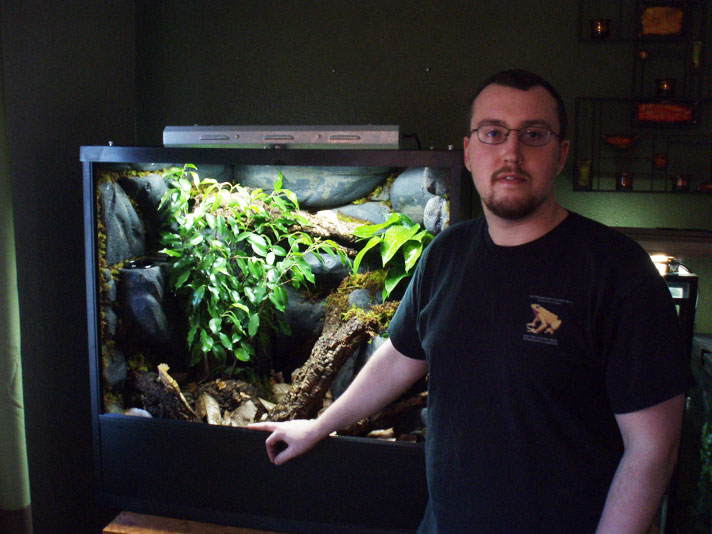
Zach Brinks
The author with his bioactive crested gecko enclosure.
Careful engineering and planning of a bioactive environment for your crested gecko is a bit more involved, both in time and cost. Instead of field collecting soil and wood, the engineers will do research to determine which options are the best for their situation, then purchase substrate and hardscape from a reputable herp supplies dealer or acquire ingredients to make their own. Substrates and wood are generally sterilized (as much as they can be, as it is basically impossible to completely sterilize biological materials) by baking at low temperatures in the oven and completely drying materials out, before being used in habitat construction. Afterward, fungi and beneficial organisms are added to the bioactive habitat in a planned and controlled manner. Doing so makes sure harmful organisms are not added to the environment.
Zach Brinks
The crested gecko makes a great "gateway reptile" for new keepers and also makes a great first introduction to bioactive herp keeping.
One strategy is not necessarily better than the other, and I have yet to see conclusive proof of harmful organisms being introduced from unsterilized materials. That being said, I’m aware of many different potential pathogens (be it from environmental pollutants, chytrid fungus, ranavirus, and many internal and external parasites) that are present in my home state (Michigan) that I certainly wouldn’t want to expose my pets to. It’s the engineering life for me.
Building Your Crested Gecko's Bioactive Enclosure
There’s a lot of choices out there when choosing a blank canvas to paint your masterpiece on—even big box pet stores have something to offer. Picking the right enclosure is somewhat subjective, but there are a few general rules to follow when planning a bioactive habitat:
Bioactive Enclosure: Bigger is Better
Compared to more traditional methods of animal husbandry, a bioactive habitat is going to need to be larger. You’re relying on beneficial bacteria, fungi and invertebrates to help break down waste and keep the habitat clean. Although small, these guys need plenty of room to live. Bioactive enclosures also tend to be a more complex environment, providing many niches with different temperature and humidity gradients. Providing a large enclosure means more usable space for your crested gecko. It also opens up the possibilities of housing a male and female(s) together. Start out with a tank that measures at least 18 by 18 by 24 inches for one adult crested gecko, and increase by about 10 gallons for each additional adult. Remember, never house more than one male crested gecko in the same enclosure.
The Right Stuff
Choosing an enclosure that’s made of durable, waterproof materials is mandatory. Avoid unsealed wood or other permeable materials. Glass or plastic (especially PVC or ABS) are good options. Glass provides plenty of clear viewing options, while plastic is lightweight. Avoid mesh or screen enclosures, as these will quickly dry out.
Ventilation Is Key
Keep in mind that you’ll want to provide cross ventilation for your bioactive crested gecko habitat. Ideally, vents below the door will allow air to enter the vivarium then exit the top screen as the air is warmed by the lighting system. This method of passive ventilation, perfected by European hobbyists decades ago, only began to be common in the US hobby in the past decade. It is a great way to ensure that your crested gecko’s environment is more similar to the forests they call home, as opposed to the stagnant, swamp-like conditions inappropriate ventilation can cause.
It’s All About the Base
Any bioactive setup is going to require several inches of substrate. Substrate is where the magic happens, and you’ll want to make sure you have room for plenty of it. If choosing a front opening tank with vents below the door (strongly recommended), make sure there’s room for at least a 3-inch layer of substrate.
Hardscape
“Hardscape” simply refers to the abiotic (non-living) structures present in the bioactive habitat, such as rock, wood and the background. These structures provide safe, secure surfaces for a crested gecko to climb and perch on, as well as work synergistically with live plants to create a convincing facade of the gecko’s natural environment.
Rock
In general, avoid using real rocks in your crested gecko's bioactive habitat. Real rock can easily shift and crush your gecko. Instead, consider many of the fake rock products now available on the market, such as those from Universal Rocks. Made out of foam cast from molds of real rocks, these reproductions are nearly indistinguishable from the real thing. Artificial rock can be secured in place with aquarium safe silicone. If you’re a fan of DIY (do it yourself), you can also construct your own rocks by carving pink rigid foam (sold at home improvement stores for insulation), then coating them with tinted DRYLOK masonry sealant. Sprinkle on some sand while the paint is still wet for a realistic texture.
Wood
When choosing wood for your crestie paradise, you’ll undoubtedly want to utilize branches or driftwood. Good choices are cork, manzanita and Malaysian driftwood, as they resist rot in a damp environment. That doesn’t mean they will not mold, however. Expect to see a bit of white or green fuzz growing during the first couple months following setup. It’s nothing to worry about. Over time, springtails and isopods will devour any mold that grows out of hand. Make sure all wood is secured in place with aquarium-safe silicone.
Background
A realistic background isn’t anything to back down from. It’s something that’s relatively quick and inexpensive to build and really adds another dimension to your crestie’s bioactive habitat. A background can be as simple as a flat piece of cork attached to the back of the terrarium with silicone, or as complicated as a custom foam background with built in planters. Regardless of which way you choose to go, keep in mind that plants will cover up the background in a few months and you won’t know the difference. Also, your crested gecko doesn’t care!
Choosing the Right Bioactive Substrate
Not too long ago there was really only one easily available source for setting up a vivarium—ABG Mix. Short for Atlanta Botanical Gardens (where this wonder substrate, actually a modified orchid mix, was first formulated), ABG mix was often used in conjunction with a drainage layer and substrate barrier to provide a durable substrate that could grow plants and harbor beneficial microfauna, such as springtails and isopods. ABG mix is most well-known from the dart frog hobby, and utilizing it in crested gecko vivaria required a bit of modification, as the mix contains tree fern fiber and other ingredients that could physically harm crested geckos, especially if ingested.
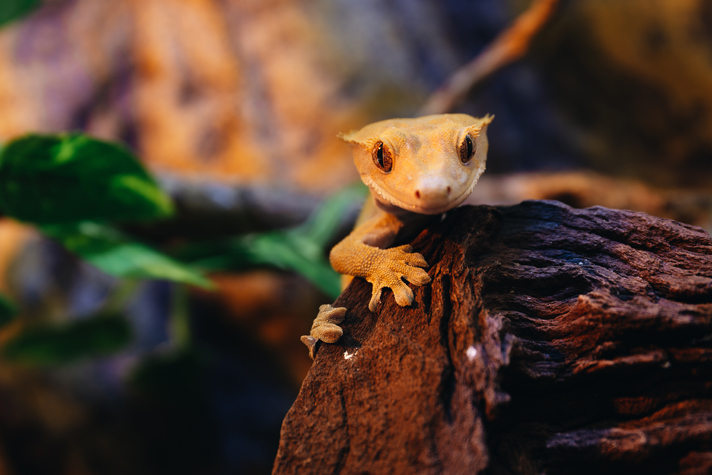
easypic shutterstock
Ample wood gives your crested gecko a platform to crawl up on.
Often, ABG mix was covered with a thin layer of coconut fiber, followed by a layer of leaf litter—dried, thick leaves from tree species such as oak or magnolia, which hold up well in wet environments. While not ideal, this did result in allowing the keeper to set up crested geckos with live plants with relative ease. It did have its downsides—ABG mix tended to dry out at the humidity and moisture levels required by crested geckos, was relatively expensive, and needed to be paired with a drainage layer, which had to be drained frequently. Because of this, many in the hobby (myself included) started experimenting and talking with more experienced keepers overseas in order to come up with other options.
There is a LOT of information out there regarding the ideal bioactive substrate. With the increase of demand comes an influx of supply; many Facebook groups, small businesses and even a few of the major reptile and amphibian supply brands have products that promise to be the next big thing in bioactive keeping. After a few years of experimenting, testing and adjusting the recipe based on experimental results and feedback from dozens of crested gecko keepers that helped refine the recipe, I settled on what is known as BioBedding Tropical, sold through www.JoshsFrogs.com. This substrate drains well while slowly wicking moisture to the surface, allowing it to function without a drainage layer in most circumstances. It grows plants well and even does a decent job incubating crested gecko eggs! Springtails and isopods love it, and it comes seeded with beneficial fungi.
The internet abounds with do it yourself recipes that contain all kinds of different ingredients, such as sand to charcoal, composted leaves to sulfur, cypress mulch to peat moss. Many of these substrates will work to some degree. It’s up to you to decide if the DIY route is for you, or if a professionally formulated, commercial substrate fits the bill. When looking at a substrate, you’ll want to choose one with the following characteristics:
- Well draining: A soaking wet substrate is a recipe for disaster. You want water to be able to freely flow through the substrate. If you grab a handful of substrate and squeeze, you want enough moisture so the substrate retains its shape, but not so much that water runs out.
- Wicks water: The last thing you want is water pooling against the bottom of the enclosure and going stagnant. A good bioactive substrate for crested geckos should be able to wick water up towards the surface, where it can evaporate and help maintain humidity.
- Does not easily compact: This ensures that the substrate will remain loose, which provides spaces for microfauna to live, and ensures harmful anaerobic bacteria do not settle in.
- Grows plants well: Plants are a big part of the bioactive equation, so you’ll want to make sure your chosen substrate supports most commonly grown plants suitable for a crested gecko bioactive habitat.
Plants
Now that you have the background and substrate, it’s time to plant! Source plants that are free from pesticides and fertilizers, if possible. Many commercial greenhouses use a wide variety of insecticides to keep their plants healthy; it’s unclear what impact these chemicals may have on your pets. Some pet stores, such as Josh’s Frogs, grow their plants in a fashion to keep them “animal safe.” If you’re not sure, ask!
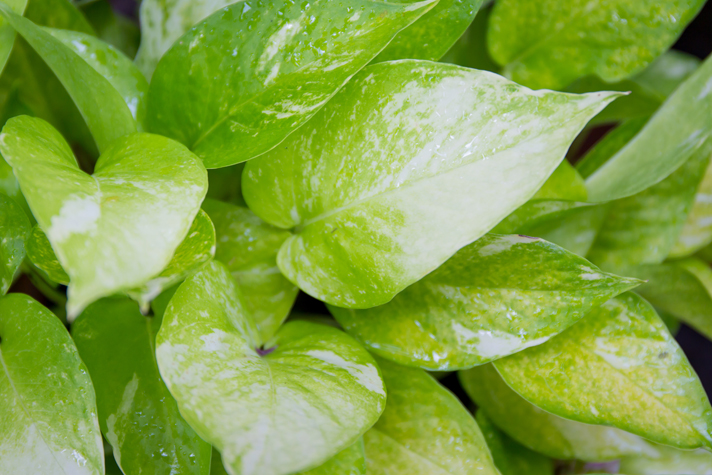
chayatorn laorattanavech/shutterstock
Pothos is hardy and will grow in virtually any situation. Broad, sturdy leaves provide cover for your crested gecko, as well as a place to grab a drink; water drops regularly collect on the leaves during misting.
Remove the plants from any soil and rinse thoroughly with tap water. Make sure to remove all soil from the roots. Then, place the plant in your tank. Most plants will go directly in the substrate at the bottom, but some may prefer mounting directly on wood or the background or in elevated planters. Make sure to research the specific care needs for your plants.
Below is a list of my top five plants for crested gecko bioactive habitats. These plants are generally easy to acquire, hard to kill, fast to grow, do not have demanding lighting needs and, most importantly, they look good!
- Pothos (Epipremnum aureum) – A common vining house plant, pothos is actually a variety of philodendron. It’s hardy and will grow in virtually any situation. Broad, sturdy leaves provide cover for your crested gecko, as well as a place to grab a drink; water drops regularly collect on the leaves during misting. Plant pothos toward the back of the enclosure at the base of the background, where it will quickly climb.
- Creeping Fig (Ficus pumila) – Another vine, creeping fig has small, bright green leaves and is fast growing. It’ll also do well planted at the base of the background and will quickly climb and grow in. It’s not large enough to provide much cover or structure for your crested gecko to use, but it’s a great filler plant and is durable enough to handle whatever your gecko can throw at it.
- Weeping Fig (Ficus benjamina) – A commonly kept house plant, weeping fig is actually a tree! It grows slowly enough in a vivarium and can be trained via regular pruning, making it a good choice for your crested gecko. It’s strong enough to support climbing geckos and should be planted in the back third of the tank, slightly off center. This is a great “feature” or “focal” plant.
- Rabbit’s Foot Fern (Davallia/Humata tyermanii) – A small epiphytic fern with fuzzy rhizomes, rabbit’s foot fern is a great choice. It can be mounted onto wood or the background with superglue or planted in background planters.
- Bromeliads (Neoregelia sp.) – Native to the neotropics, broms are not present where crested geckos are found in the wild. They sure look tropical and do well mounted onto wood or the background via their woody stem, called a stolon. Make sure to choose smooth leaved varieties, and flush the center out with fresh water weekly.
Bringing in the Cleanup Crew
Now that the plants are in, it’s time to hire some tank janitors. These guys are what makes a bioactive enclosure tick. Different organisms are harnessed to work in concert and keep the enclosure nice and tidy. They’ll also fill up the different niches present in the habitat, preventing baddies from moving in. There’s even evidence that this strategy can be successfully used to combat mites and other common reptilian maladies.
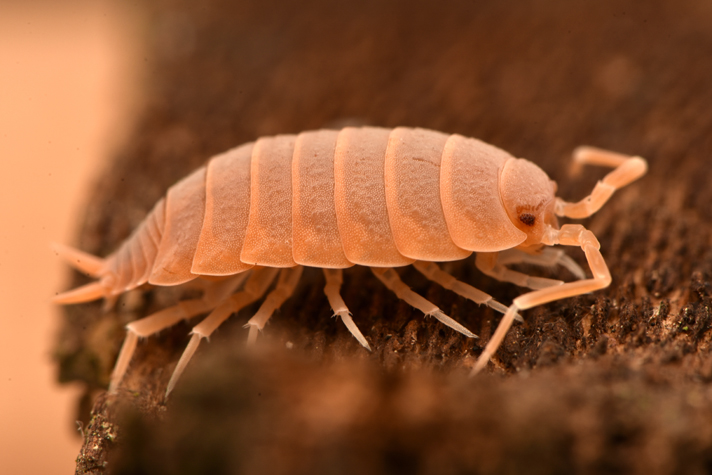
Marek Velechovsky/Shutterstock
Sometimes called pill bugs, sow bugs or rollie pollies, isopods are the most important team member on a crested gecko cleanup crew.
Fungi: Fungi are decomposers. They break down organic matter into more basic material which can then be used by plants as a source of nutrition. When we picture fungi, we typically think of mushrooms. These are actually the fruiting bodies (reproductive structures) of the fungus. Its body, made up of thin threads called mycelia, generally stay out of sight in the substrate. Fungi are seemingly omnipresent, as they’ll pop up in virtually any environment, due to reproductive spores spreading on habitat supplies or in the air. It is beneficial to add beneficial fungi to the bioactive enclosure. Many fungi grow in conjunction with plants, helping them get adequate nutrition and fueling growth. By introducing these specific types of fungi to the enclosure, you can create a mature, healthy bioactive cycle more quickly. Some products, such as Josh’s Frogs Bioactive Booster, provide beneficial fungal spores and trace elements that can be added directly to the soil.
Springtails (Collembola sp.): Tiny invertebrates that measure roughly 1/16-inch long, springtails are amazing little organisms. So named for a spring-like organ on their rear that allow them to “jump” several inches, springtails quickly attack decomposing organic matter and excess fungus, returning nutrients to the soil and helping plant growth.
Isopods: Sometimes called pill bugs, sow bugs or rollie pollies, isopods are the most important team member on a crested gecko cleanup crew. A bit bigger than springtails, some species may measure close to an inch. The single best species for our use is the tropical dwarf white isopod, Trichorhina tomentosa. This species reproduces faster than most other species and is readily available. If you’d like to add a species with a bit more color, any of the larger Porcellionides pruinosus color morphs would make a good choice. This isopod takes longer to mature but has a larger adult size and comes in different shades of gray, orange and even a bluish purple!
Both isopods and springtails will get nutrition from decomposing plants, leaf litter and even uneaten crested gecko diet. It’s a good idea to offer supplemental food. Microfauna can quickly exhaust the bioactive system of calcium and trace elements, so a food like Josh’s Frogs Clean Up Crew Cuisine is a welcome addition. They’ll also appreciate an occasional slice of cucumber. Bury any offerings an inch or so into the substrate.
If you do enough research on bioactive enclosures online, you’ll come across keepers utilizing other invertebrates as a cleanup crew, including roaches, mealworm beetles, earthworms and the like. I can’t comment on their impact in the bioactive enclosure, but I can say I’ve had bioactive crested gecko habitats up and running for years utilizing just fungi, springtails and isopods. If you’re feeling adventurous, feel free to do further reading for some other potential tank janitors.
Topping it Off
Now that your tank janitors have been introduced, it’s time to top off your substrate with a healthy layer of leaf litter. I prefer to use a combination of live oak and magnolia leaves, as the different sizes and textures add a more natural appearance to the enclosure. Make sure the leaves were collected from a pesticide- and herbicide-free area and are completely dry. These steps will help reduce the chances of introducing harmful organisms or chemicals to your vivarium. You can also go a step further and rinse the leaves with water, pat dry, spread on a cookie sheet and heat up to 150˚F in the oven for at least an hour. This heat treatment will knock out any unwanted hitchhikers. Just make sure to watch them closely, as you don’t want to burn your house down while building one for your crested gecko!
Dried seed or nut pods can also be added for additional visual appeal. Popular choices are buddha nut, magnolia seed, acacia and oak pods. These are entirely optional, and often end up being a several months buffet for your cleanup crew.
Maintaining the Cycle
Your tank is now up and running! Soak it heavily with distilled or reverse osmosis water, wipe the glass down with paper towel, plug in the lights and you’re off! I recommend letting your tank sit and run for a month or so before adding your crested gecko—that way, you have time to monitor temperature and humidity, make sure the plants are growing well and rooted in, microfauna has had time to establish, and the initial fungal bloom has subsided. During this time, you can dial in the lighting, misting, temperature and cleaning routine.
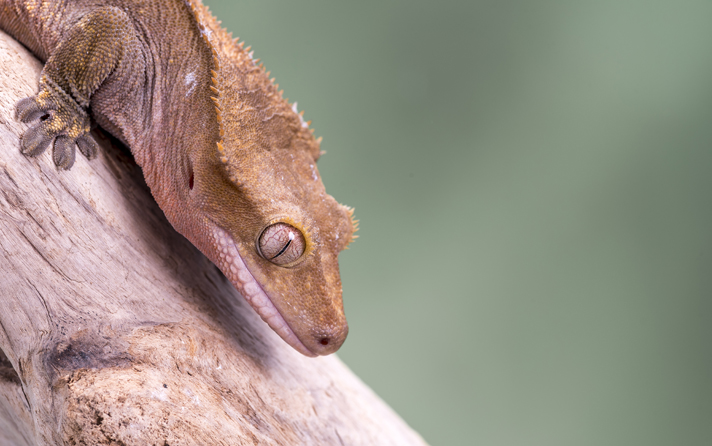
GParker/Shutterstock
The crested gecko is one of the most popular reptiles kept as a pet.
Lighting for all but the largest bioactive crested gecko vivaria should be a simple affair. Crested geckos do not require UV lighting, although a small amount of low intensity UVB is appreciated. Plants should be selected for their low-light needs. Often, a dual T8 fluorescent fixture that runs the entire length of the enclosure is enough. Many of the commonly available front opening terraria have matching light canopies available. 26W compact fluorescent bulbs or screw-in type LED lights can be used in the canopies to provide a stylish source of lumens for plant growth. Light bulbs should have a color temperature in the 5000-6500K range and are commonly called daylight bulbs. Run the lights via a timer on a basic 12 hours on/12 hours off cycle.
If you have a single enclosure and don’t travel, I recommend sticking to hand misting via a hand pump style sprayer. If you’re a fan of automation or will be away from the enclosure for days at a time, an automatic misting system, such as a MistKing or Exo Terra Monsoon may be in order. Either way, make sure to use distilled or reverse osmosis water for misting. You’ll want to mist one to two times a day, bring the humidity up to over 80 percent, then allowing to fall below 60 percent before misting again. A fine mist will provide droplets for your gecko to drink, as well as knock gecko poop down to the substrate where it will be quickly consumed. Foggers do not have any place in a crested gecko vivarium—they simply add too much water to the system.
Crested geckos do great at what most of us consider room temperature; if you can maintain the enclosure between 70-78˚F, you do not need to add any supplemental heat. If the enclosure is routinely falling into the 60s at night, consider adding some heating cable in the enclosure. A low wattage basking bulb can be used for cold days. If the tank’s temperature exceeds 80˚F, take quick action to drop the temperature. Exposure to temperatures over 82˚F can be fatal to a crested gecko.
Cleaning is minimal in a crested gecko bioactive habitat and primarily involves cleaning poop off the glass. Plants will need to be trimmed, and leaf litter should be topped off every six months or so. Additional beneficial fungi and trace elements can be added to the substrate every few months, and microfauna will appreciate the occasional supplemental feeding. The substrate should be carefully aerated and turned with a plastic fork every couple months to prevent it from compacting and provide air and microfauna with a direct path to new habitat in the soil.
Conclusion
Now that you’ve seen what it takes to go bio, I sincerely hope you’ll give it a try. Much like the use of live sand and live rock changed the marine aquarium hobby forever, enabling aquarists to maintain miniature coral reefs at home, bioactive habitats promise to help us keep our reptilian pets in a better, more natural way than ever before. While bioactive keeping does involve a larger initial time and financial investment, the result is a visually appealing, low-maintenance work of art that can easily be the focal point of any living room, with plenty of time left over for enjoyment. Your crested gecko will thrive in a more naturalistic private jungle of its very own, benefiting from a more complex, enriched environment. So what’s stopping you? Let’s go bio!
Zach Brinks is a lifelong herper. He has kept and bred reptiles and amphibians since he was 5, and has bred more than 100 species of herps in the last three decades.

